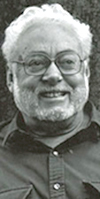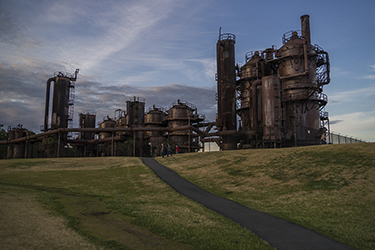|
Subscribe / Renew |
|
|
Contact Us |
|
| ► Subscribe to our Free Weekly Newsletter | |
| home | Welcome, sign in or click here to subscribe. | login |
Environment
| |
August 7, 2018
Richard Haag is remembered for his designs, inspiration and passion
Journal Staff Reporter

Richard Haag, an award winning landscape architect who designed the internationally respected Gas Works Park in Seattle and founded the Department of Landscape Architecture at the University of Washington, died May 9 of natural causes. He was 94.
Haag was also known for designing Bloedel Reserve on Bainbridge Island, redesigning Seattle Center after the World's Fair to make it a public park, and designing Steinbrueck Park in Seattle with Victor Steinbrueck.
His work is noteworthy for its inventive approach, sensitivity to the environment and adaptive re-use of structures and facilities. He was also a respected and passionate teacher who encouraged students to fight for great landscape architecture, his fellow professionals said.
“He was an inspiration and a catalyst and a poet. An incredible teacher,” said Thaisa Way, a professor of landscape architecture at the UW. “He was in the deepest sense of the word a mover and a shaker. It wasn't just that he had some good ideas, he was really focused on improving the public realm and the public landscape.” Way, who wrote the book “The Landscape Architecture of Richard Haag,” said one of those good ideas was seeing the potential in the Gas Works Park site, a neglected area with detritus left from the gas works and tar plants, where not a blade of grass would grow.
Haag worked with a soil scientist and fertilizer salesman to find a way to aerate the soil and add organic materials so it would heal itself. He persuaded the city to let him try it on a little plot of the site. When it worked, Haag got the commission.
Gas Works is considered the first bio-remediated park in the world, said Way, who noted that some soil and construction debris could not be taken care of on-site, so it was capped and is now Kite Hill.
“That was the kind of imagination and leadership he showed, to see something in what everybody else looked at as a disaster,” Way said.
Haag was born in Louisville, Kentucky in 1923. His father, Rudy, was a nurseryman, and his mother, Luthera, worked on the business side of the nursery.
Haag enlisted in the Army during World War II. He attended the University of Illinois, and received a bachelor's of landscape architecture from the University of California at Berkeley, and a master's of landscape architecture from Harvard University Graduate School of Design. He won a Fulbright to study in Japan for two years, and was a resident at the American Academy in Rome.
Haag worked with a number of people in Berkeley, including Lawrence Halprin, who designed Seattle's Freeway Park.
In the late 1950s, he came to Seattle to found the UW's landscape architecture program, but there were no students at first so he started his own practice, said Way. That firm, Richard Haag Associates, closed in June 2016, after completing over 500 projects.
Way said Haag initially taught some architecture students and persuaded a number of them to switch to landscape architecture. They include Grant Jones of Jones & Jones Architects and Landscape Architects, Laurie Olin of Olin in Philadelphia, and the late Robert Hanna. Jones' firm is nationally known for ecological design; Hanna and Olin designed Westlake Park; and Hanna also worked on Bryant Park in New York City, Way said.
Olin said Haag was a great landscape architect who influenced others in the field. He also was a well-loved and remarkable teacher. “You should be proud you had him for so long,” he said.
People come from around the world to see the serene “garden rooms” at Bloedel Reserve, Olin said. Haag kept and revealed some of the big stumps on the site, creating something akin to a Japanese temple garden, he said.
Bloedel Reserve and Gas Works Park are both radical but completely different, Olin said. Haag “teased out the genius of each place,” making something from the ruined gas works and the ruined forest that others did not envision.
Olin worked with Haag on the fight to save Pike Place Market in Seattle. He said Haag was always engaged in public fights that focused on the quality of the environment and public life.
Peter Walker, a partner with PWP Landscape Architecture in Berkeley, worked with Haag in Halprin's office in the mid-1950s. He said Haag was one of the funniest and the most passionately political people he's ever met — an environmentalist in the 1950s when few people were.
“He would go to city hall and yell and scream,” said Walker. “You didn't want to be on the other side of Rich's passion. He was formidable.”
Walker said Haag also trained some great landscape architects, and encouraged them to stand up and make a difference, including the late Frank James who taught at Harvard.
Barbara Swift of Swift Co., a landscape architecture firm in Seattle, was a student of Haag's at the UW in the early 1970s. She described the experience as “mind blowing, wonderful, extraordinary, terrifying.”
Haag challenged his students to look at projects in an environmental, social, ethical and political way. He taught them that dealing with the built environment meant that they must engage with all those interlocking issues, she said, and it was a heavy responsibility.
Swift said she knew she wanted to go into landscape architecture before she studied with Haag, “and he sealed the deal.”
Haag did not want a memorial service after his death, nor for that matter an obituary, said Way. “He would see it just as a distraction from the important work — the work we're doing in the public life.”
Haag is survived by his wife, Cheryl Trivison, founder of Friends of Gas Works Park, his children and grandchildren.
Lynn Porter can be
reached by email or by phone
at (206) 622-8272.



